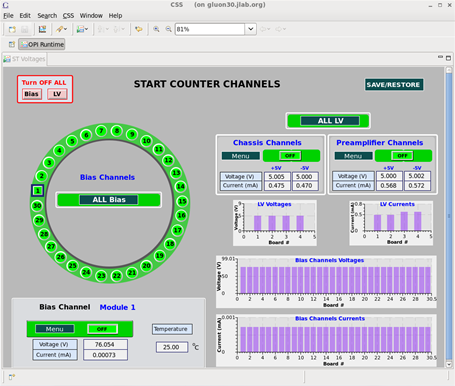Start Counter Shift
Contents
Detector Description
The start counter is a scintillator hodoscope surrounding the target region. It consists of 30 identical scintillator counters (each counter thus subtends 36 degrees of azimuth). Each counter has a nose section, and a straight section so that the array as a whole forms a cylinder-like region of about 40 cm, with an radius of about 8 cm, and a downstream nose cone of going down to 2 cm from the beamline at an angle of 18.5 from the cylinder-like region.
Each counter is read out by a set of four 3mmx3mm Hamamatsu MPPCs. These in turn are arranged on 10 circuit boards, each board responsible for three of the counters. Each set of four operates with a common bias voltage. The output of the four MPPCs for a channel is summed and amplified locally. Each channel (set of four) is instrumented with thermisters for temperature monitoring. Cooling is done by forced air at room temperature.
Monitoring Runs
To monitor the performance and degradation of the SiPMs over time special runs are taken in RAW mode with sparsification turned off
by setting the readout threshold very low. The following is a short description of how to take such data:
- Take the data while there is NO BEAM!
- Select Expert mode in the DAQ gui
- Select RAW_ALL_NOSPARS.conf for the electronics configuration
- Use regular readout configuration hd_all.xxx
- Set front panel random trigger to 2 kHz (is usually set at 100 Hz)
- Take data for about 10 to 20 files
After the data is recorded set the random scaler back to 100 Hz.
Shift Duties
Shift crews should be monitoring the following:
- MPPC bias voltages
- amplifier power (low voltage supplies)
- statistical information from raw data ("monitoring histograms")
MPPC bias voltages and amplifier power
Both of these classes of voltages are supplied by Weiner MPOD modules. Shift crews should monitor the GUI to insure all channels are on during data taking. Fron the Main Action Bar, click on ST Voltages in the PSC/PS/ST section. The following GUI will appear:
There are two major classes of voltages:
- SiPM Bias Voltage (Bias)
- Low Voltage Electronics Power (LV)
for LV there are two minor categories
- Amplifier Power for the ST3 Board (LV: Chassis)
- Pre-Amplifier Power for the ST2 Boards (LV: Preamplifier)
Power Up and Power Down
The power on sequence is:
- Turn on all low voltage
- Turn on all bias voltages
The power down sequence is:
- Turn off all bias voltages
- Turn off all low voltage
All of these actions for bias and low voltage can be accessed from the pull-down menus labeled "ALL Bias" and "ALL LV" respectively.
Voltage Monitoring
Most important properties of individual bias and low-voltage channels will be monitored automatically by the EPICS alarm system. Shift crews need to respond to alarms as they arise. To facilitate this, each shift a check should be made that the Start Counter MPOD F HV is up and running.
The conditions that may cause EPICS alarms are:
- tripped voltage
- read-back voltage out-of-range
- supply current out-of-range
- EPICS communication lost
In responding to alarms shift crews should check the guidance for the alarms as provided by the alarm handler.
Save and Restore
The "SAVE/RESTORE" button allows you to save (record) voltage set-points to disk or restore set-points from a previous save set. This can be done either for all bias voltage or for all low voltage set-points.
Statistical Information
Each run produces a set of monitoring histograms that should be compared to nominal histograms and scanned for anomalies. The histograms include:
- occupancy, channel-by-channel
- timing distributions
- amplitude distributions
Expert personnel
The individuals responsible for checking that the Start Counter is ready to take data and setting its operating parameters are shown in following table. Problems with normal operation of the Start Counter should be referred to those individuals and any changes to their settings must be approved by them. Additional experts may be trained by the system owner and their name and date added to this table.
| Name | Extension | Date of qualification |
|---|---|---|
| Beni Zihlmann | 269-5310 | June 12, 2014 |
